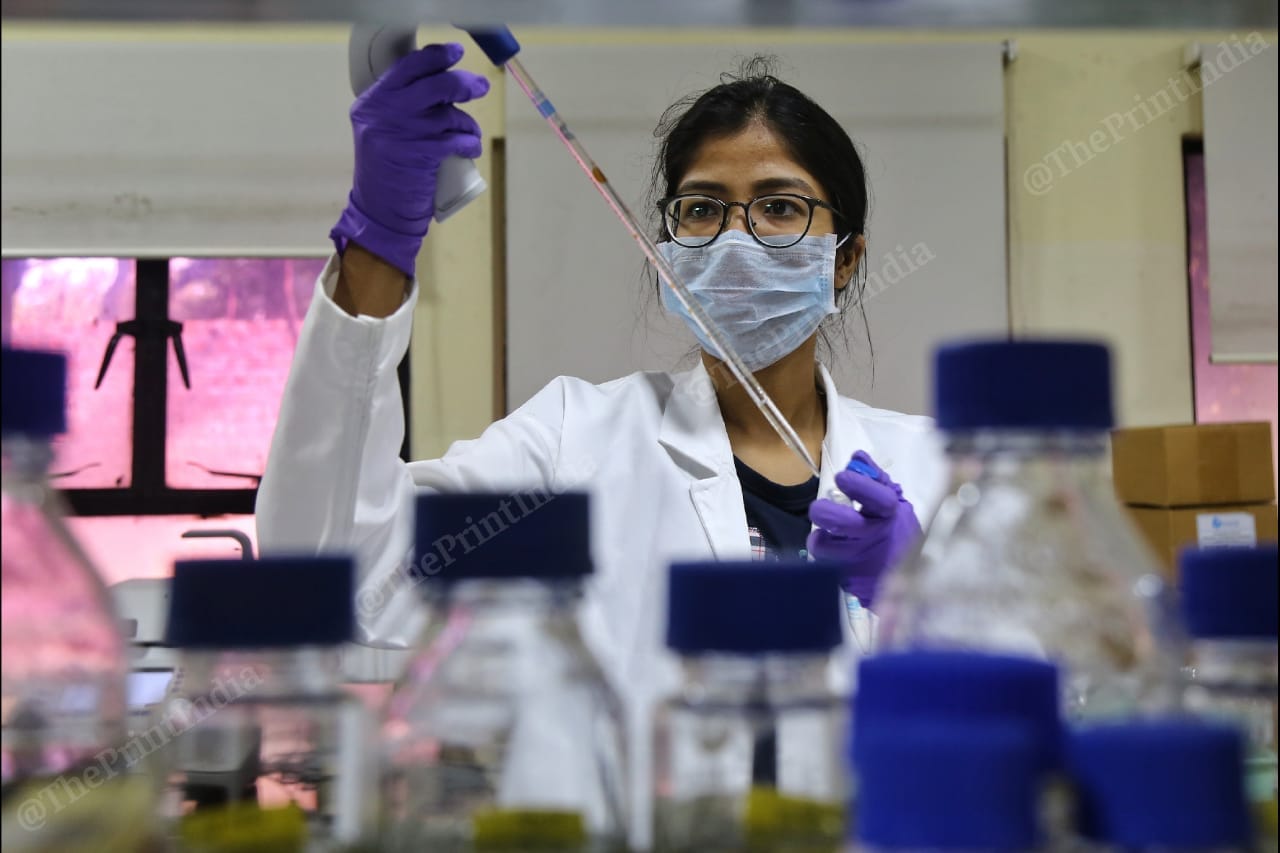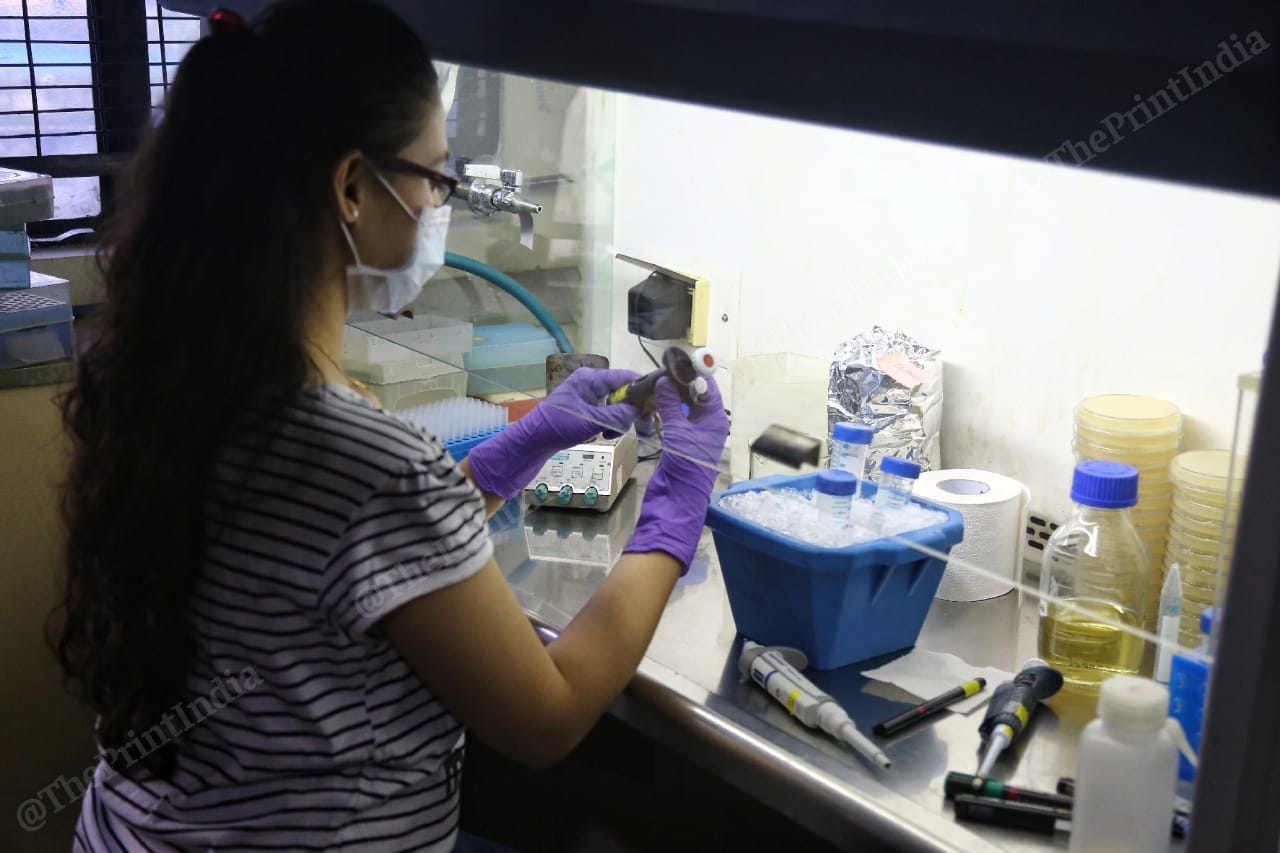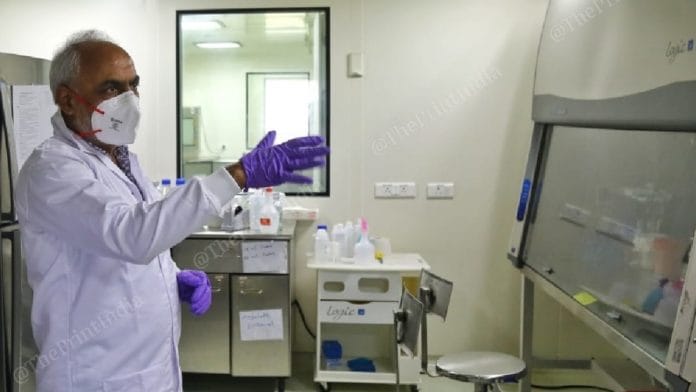Hyderabad: A new Covid-19 test developed by the Centre for Cellular and Molecular Biology (CCMB) can test 20,000-50,000 Covid-19 samples daily — a “breakthrough” that could significantly enhance India’s testing capacity, according to the institute’s director Rakesh Mishra.
In an interview to ThePrint, Mishra said if all goes well, the new ‘Next Generation Sequencing’ (NGS) kit will be operational in about four weeks. “It will change the game,” he said.
Presently, cities like Hyderabad and Bengaluru are conducting about 1,000-2,000 tests every day, he said. In the last 24 hours, India conducted tests on 1.08 lakh samples.
According to Mishra, the new kit will offer diagnosis through sequencing of several pieces of the virus genetic material, and lessen the chances of inaccurate testing.
India is currently testing for Covid-19 through real-time polymerase chain reaction (RT-PCR) technique. “In the current method, nasal swabs are taken from a person in VTM (viral transport medium). The liquid is taken from this, RNA (ribonucleic acid) is extracted and RT-PCR test is conducted,” said Mishra.
The isolation of RNA makes RT-PCR expensive and more time-consuming. The NGS technique will do away with that, he said.
“A collection centre can collect thousand samples in one go, as more than that can be a logistical problem, and we will collect samples from 20 to 50 centres,” said the CCMB chief. The test results would come in two days and at one-third the cost but with the “same amount of efficiency”, he added.
The new testing module will also help in surveillance of Covid-19 suspects, he said. “The ‘Next Generation Sequencing’ will help in diagnosis and surveying the disease at a much faster rate,” Mishra told ThePrint.
The RT-PCR test works by sequencing and then testing with a fluorescent dye just one sample at a time. The NGS tests are done under a similar mechanism, but the difference between it and single DNA sequencing (called Sanger sequencing) is the volume. The NGS method allows for virologists and technicians to sequence hundreds of thousands of samples in parallel due to the improved design of sequencing machines, which can hold multiple samples instead of just one.
This is a ‘high-throughput’ process that saves both time and cost. Additionally, the improved machines also come with improved sensitivity and are capable of detecting the virus RNA with fewer chances of a false negative.
The project is in collaboration with Syngene, a Bengaluru-based company. The process for the kit’s approval from the Indian Council of Medical Research (ICMR), India’s nodal Covid-19 testing body, is underway, said the CCMB director.
The effort has come from the Hyderabad-based primary research institute, Council of Scientific and Industrial Research (CSIR) centre, which has been working on enhancing Covid-19 testing in India.
Also read: Cases, fatality rate or deaths per million, India in control of Covid: Niti Aayog expert
‘Will be in better position with more testing’
In response to ICMR’s latest guidelines that focus on testing only symptomatic patients, Rakesh Mishra said, “Testing is like seeing what’s around us. If you see more, you will be more informed.
“If you give me a choice, I will test everybody as it helps understand where to do a lockdown or where to resume business,” he said.
Noting concerns about resources among governments, he said, “… If we test more, we will be in a better position.” He added that healthcare workers, in particular, must be tested at least every two weeks.
‘Vaccine likely in first half of next year’
With world’s eyes set on developing a Covid-19 vaccine as soon as possible, Mishra said the CCMB was also working on one. In an ideal scenario, the vaccine the institute is developing will be ready for use by the first half of next year, he added.
The research institute has established stable virus cultures using coronavirus from patients’ samples. “This will help us in vaccine development and drug testing to fight Covid-19. Now we can confidently say that we’re done with a major chunk of the work as for isolating the infectious viruses from other isolates,” said Mishra.

The CCMB, which cultures the virus in its labs, uses vero cells (from the kidney of monkeys) to establish cell lines to grow the virus for developing a vaccine.
“We have a special Bio Safety level 3 lab where we culture the live virus,” he said. CCMB is also using a version of the vero cell called E6. It is also getting human epithelial cells from the lungs from I-Step, another company in Bengaluru, in a joint collaboration. “This is exactly from where the virus spreads — so these cells help us study it properly,” he said.
Out of a team of 60 people working on the vaccine, 45 are students of the institute who volunteered to be part of the process.
Also read: Covid patients with high blood pressure face ‘double risk’ of death, says Chinese study
‘Virus originated in mid-November to December’
The novel coronavirus originated in mid-November to December in China, the CCMB director told ThePrint. The institute was able to calculate this based on the “timing of the mutation rate”.
The scientists working at the institute discovered that after the infection originated from Wuhan in China, it came to Southeast Asia in mid-February when a new clade emerged — A3i, which is unique to India and Southeast Asia, and is the second most dominant in the country.
“It contributes to 41 per cent of the infection among patients in the country,” he said.
The two clades in India are A3i and A2a, which is known across the world. A clade is a cluster of SARS CoV-2 (novel coronavirus) that are similar in evolution and grouped together due to certain characteristic mutations.
Mishra said the virus reached Hyderabad first from where it spread in India. Although some isolated cases did come to Kerala from Wuhan, the major cases first arrived in Hyderabad and across Telangana followed by Tamil Nadu and some parts of Delhi before the lockdown was enforced on 25 March, he said.
“From the mutation, it theoretically appears that it could affect it (the virus) by slowing down the spread and showing up in patients in a less symptomatic manner … The virus will be less efficient. It may spread less efficiently, it may be less symptomatic. Either of the two can happen,” he said, adding that it’s too early to tell but there is sufficient evidence to investigate this further.
CCMB also working on alternative to plasma therapy
The CSIR institute director also highlighted that CCMB is working on an alternative to plasma therapy, in partnership with a Hyderabad-based company and the University of Hyderabad.

“Since we have an immense amount of inactivated virus to work on the vaccine, one can also inject that in large animals, say a horse, and make an antibody in the horse and collect it and use it as an antidote in patients to test it,” he said.
“A Hyderabad-based company is taking the virus from CCMB and using it to test in horses. It will be like replacing plasma therapy as one of the options to treat patients, so we’re hoping to get beneficial results from there too,” he said, adding that horse antibodies have been used since 1890.
‘Covid-19 made India realise importance of science’
Talking about how scientific solutions have been overlooked in India, Rakesh Mishra said, “We spend very little money on research, science and technology, but we need to realise solutions to problems lie in science.”
Referring to how the economy world over has been hit due to coronavirus, he said the solutions will come from a lab. The government and big industrial houses have perhaps realised this amid the spread of Covid-19 — a positive side-effect of the disease.
Also read: AstraZeneca’s cancer drug shows early signs of promise in treating severe Covid cases







They commercialize immediately. What are they waiting for. Research labs should must take these things to logical conclusion with no time loss. May be this is difference between India and other countries.